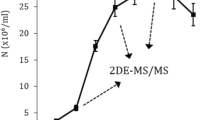Abstract
In the present study, an enzymatical and structural analysis ofLeishmania mexicana cell-surface components was carried out, demonstrating that protease and acid phosphatase activities were present at theL. mexicana cell surface. These findings correlate with the expression of the main components detected on the surface ofL. mexicana promastigotes: the 50-kDa component is responsible for the acid phosphatase activity, whereas glycoprotein 65 (gp65) was characterized as the structural polypeptide of the surface protease. Furthermore, the 50- and 65-kDa antigens were found to be structurally different, inasmuch as no homology was observed in their peptide digestion profiles. The results presented in this communication confirm heterogeneity in the expression of the surface components ofL. mexicana promastigotes at both the structural and the biochemical level.
Similar content being viewed by others
References
Barbieri CL (1988) Acid phosphatase isoenzyme mapping inLeishmania. Exp Parasitol 67:159–166
Blackwell JM, Ezekowitz RAB, Roberts MB, Channon JY, Sim RB, Gordon S (1985) Macrophage complement and lectin-like receptors bindLeishmania in the absence of serum. J Exp Med 162:324–331
Bordier C (1987) The promastigote surface protease ofLeishmania. Parasitol Today 3:151–153
Bouvier J, Etges R, Bordier C (1987) Identification of the promastigote surface protease in seven species ofLeishmania. Mol Biochem Parasitol 24:73–79
Button LL, McMaster WR, (1988) Molecular cloning of the major surface antigen ofLeishmania. J Exp Med 167:724–729
Button LL, Russell DG, Klein HL, Medina-Acosta E, Karess RE, McMaster WR (1989) Genes encoding the major surface glycoprotein inLeishmania are tandemly linked at a single chromosomal locus and are constitutively transcribed. Mol Biochem Parasitol 32:271–284
Chaudhuri G, Chang KP (1988) Acid protease activity of a major surface membrane glycoprotein (gp63) fromLeishmania mexicana promastigotes. Mol Biochem Parasitol 27:43–52
Chang KP (1983) Cellular and molecular mechanisms of intracellular symbiosis in leishmaniasis. Int Rev Cytol [Suppl], 14:267–302
Colomer-Gould V, Quintao LG, Keithly J, Nogueira N (1985) A common major surface antigen on amastigotes and promastigotes ofLeishmania species. J Exp Med 162:902–916
Coombs GH (1982) Proteinases ofLeishmania mexicana and other flagellate protozoa. Parasitology 84:149–155
Etges RJ, Bouvier J, Hoffman R, Bordier C (1985) Evidence that the major surface proteins of threeLeishmania species are structurally related. Mol Biochem Parasitol 14:141–149
Etges R, Bouvier J, Bordier C (1986) The major surface protein ofLeishmania promastigotes is a protease. J Biol Chem 261:9098–9101
Fong D, Chang KP (1981) Protease activity of a parasite protozoan.L. mexicana. J Cell Biol 91:43A
Gardiner PR, Jaffe CL, Dwyer DM (1984) Identification of cross-reactive promastigote cell surface antigens of someLeishmania stocks by125I labeling and immunoprecipitation. Infect Immun 43:637–643
Glew RH, Czuczman MS, Diven WF, Berens RL, Pope MT, Katsoulis DE (1982) Partial purification and characterization of particulate acid phosphatase ofLeishmania donovani promastigotes. Comp Biochem Physiol B 72:581–590
Gottlieb M, Dwyer DM (1981)Leishmania donovani: surface membrane acid phosphatase activity of promastigotes. Exp Parasitol 52:117–128
Handman E, Goding JW (1985) TheLeishmania receptor for macrophage is a lipid containing glycoconjugate. EMBO J 4:329–336
Handman E, McConville MJ, Goding JW (1987) Carbohydrate antigens as possible parasite vaccines. Parasitol Today 8:181–185
Hassan HF, Coombs GH (1987) Phosphomonoesterases ofLeishmania mexicana and other flagellates. Mol Biochem Parasitol 23:285–296
Hernández AG, Arguello C, Ayesta C, Dagger F, Infante RB, Stojanovic D, Dawidowicz K, Riggione F, La Riva G (1981) The surface membrane ofLeishmania. In: Slutzky GM (ed) The biochemistry of parasites. Pergamon, Oxford, pp 47–65
Hernández AG, Misle A, Urdaneta J, Dagger F (1987) The effect of tunicamycin onLeishmania braziliensis. Glycosilation of the cell surface components. Mol Biol Rep 12:103–110
Hernández AG, Payares G, Misle A, Dagger F (1989) The heterogeneity ofLeishmania cell surface antigens. Parasitol Res (in press)
Kweider M, Lamesre JP, Darcy F, Kusnierz JP, Capron P, Santoro F (1987) Infectivity ofLeishmania braziliensis promastigotes is dependent on the increasing expression of a 65000-dalton surface antigen. J Immunol 138:229–305
Laemmli UK (1970) Cleavage of structural proteins during assembly of the head of bacteriophage T4. Nature 227:680–685
Lischwe MA, Ochs D (1982) A new method for partial peptide mapping usingN-chlorosuccinimide/urea and peptide silver staining in sodium dodecyl sulfate-polyacrylamide gels. Ann Biochem 127:453–457
Lovelace JK, Gottlieb M (1986) Comparison of extracellular acid phosphatases from various isolates ofLeishmania. Am J Trop Med Hyg 35:1121–1128
Markwell MK, Fox GF (1978) Surface iodination of membrane proteins of viruses and eukaryotic cells using iodo-gen (1,2,4,6-tetrachloro-3,6-diphenyl glycoluryl). Biochemistry 17:4807–4817
McLaughin J, Injeyan HA, Meerovitch E (1976) The subcellular distribution and properties ofCrithidia sp. hydrolases with particular reference to pyrophosphate and orthophosphate monoester phosphohydrolases. Can J Biochem 54:365–381
Ramirez JL, Guevara P (1987) The ribosomal gene spacer as a tool for the taxonomy ofLeishmania. Mol Biochem Parasitol 22:177–183
Remaley AT, Das S, Campbell PI, La Rocca GM, Pope MT, Glew R (1985) Characterization ofLeishmania donovani acid phosphatases. J Biol Chem 260:880–886
Russell DG (1987) The macrophage attachment glycoprotein gp63 is the predominant C3-acceptor site onLeishmania mexicana promastigotes. Eur J Biochem 164:213–221
Russell DG, Wilhelm H (1986) The involvement of the major surface glycoprotein (gp63) ofLeishmania promastigotes in attachment to macrophages. J Immunol 136:2613–2620
Russell DG, Wright SD (1988) Complement receptor type 3 (CR3) binds to an Arg-Gly-Asp-containing region of the major surface glycoprotein gp63 ofLeishmania promastigotes. J Exp Med 168:279–292
Saito K, Suter E (1965) Lysosomal acid hydrolases in mice infected with BCG. J Exp Med 121:727–739
Author information
Authors and Affiliations
Rights and permissions
About this article
Cite this article
Manenti, S., Kutner, S., Rascon, A. et al. Biochemical evidence of the antigenic cell surface heterogeneity ofLeishmania mexicana . Parasitol Res 76, 301–305 (1990). https://doi.org/10.1007/BF00928183
Accepted:
Issue Date:
DOI: https://doi.org/10.1007/BF00928183




